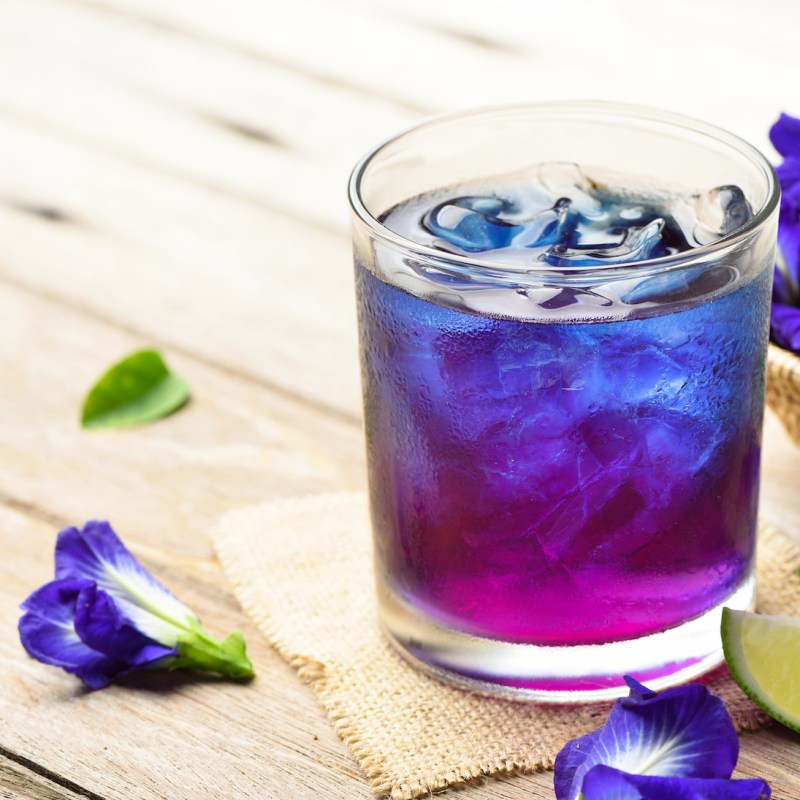
If you’ve been seeing a lot more blue and purple food as you travel the world, you’re not imagining things. Bright indigo and violet shades have been popping up on everything from tea lattes to Hollandaise sauce. What you’re seeing isn’t the result of food coloring. In fact, it’s 100 percent natural — and totally delicious! Say hello to butterfly pea, the new global food trend.
Videos by TravelAwaits

What Is Butterfly Pea?
Butterfly pea is a beautiful cobalt blue flower that is sometimes called Asian pigeonwings, bluebellvine, blue pea, butterfly pea, cordofan pea, or Darwin pea. It belongs to the plant family Fabaceae, which means it’s related to other pretty blooms like sweet peas, lupins, and cape lilac (along with garden classics like various peas and beans). It grows as a creeper vine and is often added to gardens as an ornamental plant.
The butterfly pea flower has been a gorgeous addition to South East Asian cuisine for centuries, but over the last five years or so, it’s becoming increasingly trendy — and you won’t have to look very far to see its influence at a restaurant, cafe, or bar near you.
How Do You Eat It?
If butterfly pea did nothing but hang out on the side of a plate and look pretty, it would still be doing an awesome job if you ask me. But being a garnish isn’t what this plant is known for. Southeast Asian chefs and home cooks have long employed butterfly pea as a natural food coloring. It’s often used to transform rice dishes and desserts.
I tried it for the first time in Bangkok’s flower market. I enjoyed a creative cooking class there, and we used butterfly pea to dye the noodles for our pad thai! In Malaysia, butterfly pea turns the rice used in nashi kerabu (a rice dish with dried fish or fried chicken, crackers, pickles, and other accouterments) into a dreamy pale blue. In Thailand and Myanmar, you’ll sometimes find the blossoms dipped in batter and deep fried (which I bet anyone who enjoys deep-fried stuffed zucchini blossoms would love).
I often notice butterfly pea influencing ingredients and sauces not normally associated with Southeast Asian cuisine. For instance, I’ve seen a restaurant turn their Hollandaise sauce into a bright blue to make a splash on their Mother’s Day brunch menu.

Drinks With Butterfly Pea
While butterfly pea makes rice and noodles pop, it really shines with beverages. Butterfly pea flower tea is indeed a deep blue shade. In fact, TEALEAVES, a Vancouver-based company who makes custom tea blends for many of the world’s finest hotels, collaborated with Pantone to make a blue butterfly pea tea in celebration of Pantone’s color-of-the-year program. I’ve also seen the tea used in milk-based tea lattes. The colors were truly amazing! In Philadelphia, a company I love, Vernick Coffee Bar, combines butterfly pea tea with matcha and milk to make an unforgettable matcha latte.
But just being a brilliant tone of blue isn’t enough for this awesome bloom. Butterfly pea also changes color! When you add acid to a butterfly pea-based beverage, it changes to purple-pink. So, yes, if you have blue butterfly pea tea and you add in a squirt of lemon juice, the color will change before your eyes. I once had butterfly pea tea ice cubes in lemonade. As the ice melted, the beverage changed color. Amazing!
Of course, bartenders and mixologists are all over butterfly pea. How could they not? Having color-changing cocktails (sometimes called “mood cocktails”) is the kind of showstopper that all bars love. There is even a color-changing gin that turns from blue to pink when combined with a carbonated mixer (as it causes a change in pH levels).
What Does Butterfly Pea Taste Like?
You’d think a vibrant bloom like butterfly pea would have an equally vibrant taste, but it’s actually the opposite. A description I really like comes from a January 2016 Bon Appétit article. It says butterfly pea is: “Earthy and woody — more similar to a fine green tea than it is to Blue Curaçao or Jolly Ranchers.” I like to say that if you enjoy drinking camomile tea, you’ll like butterfly pea tea.
However, it’s worth noting that butterfly pea is often combined with other flavors. When it comes to beverages, it seems that butterfly pea is wanted for its bright color and not its subtle flavor. As such, you’ll often see it paired with lemongrass in teas. There’s often a lot of sugar in butterfly pea lemonades and iced drinks since lots of lime and lemon juice are added for the color-changing effects. And in cocktails, butterfly pea’s subdued flavor is rarely encouraged to shine.
Where Can You Try It?
Butterfly pea-enhanced food is available at many Malaysian, Thai, and other Southeast Asian-inspired restaurants and pastry shops. You’ll see it on the menu at any hip cocktail bar. But I have to say my own preference is to go to the source. Who wouldn’t want to snack on it in Malaysia? After all, they’ve been cooking with this awesome product for hundreds of years. They know what they’re doing!
Butterfly Pea And Traditional Wellness
Butterfly pea is also an important ingredient in Ayurvedic medicine and is reputed to help with memory, stress reduction, and depression. Knowing this, I’m surprised that I haven’t seen much in the way of butterfly pea wellness treatments or spa packages yet. It seems that its role in Ayurvedic medicine is mostly confined to traditional treatments and hasn’t yet moved on to things that are loosely inspired by Ayurvedic practices. Perhaps this is the next hot travel trend?
Butterfly pea is also very important in traditional Chinese medicine, where it’s associated with enhancing female libido. Really! The species’ botanical name is clitoria ternatea and, yes, the flowers were thought to resemble female genitalia. (“Ternatea” is much less interesting. It’s for the Indonesian city of Ternate, where the specimens examined by botanist Carl Linnaeus originated.)

Fun Fact: Butterfly Pea Is More Than Just A Pretty Face
This easy-to-grow plant is considered a revegetation species. Its roots combine with the soil in a symbiotic relationship known as rhizobia. Gardening fans will recognize that term right away, as it’s a crucial component of transforming soil quality by making nitrogen into a plant-friendly form. Is there anything that butterfly pea can’t do?
